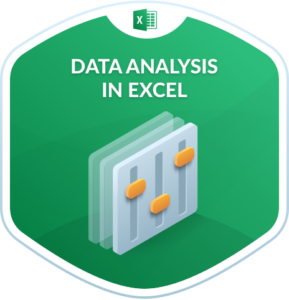Top Excel for Accounting Courses - Q2 2023
Our Expert Picks
Time to Complete:
# Enrolled:
Content Coverage:

Lecturer Quality:

Quiz Quality:

Exercise Quality:

Our Expert Review
Content Coverage (5/5)
The course contains four weeks of intermediate-level Excel training, starting each week with a verbal and clear introduction to what the learners are expected to review, in detail, per the outlined course learning objectives.
The time commitment needed to complete the course over four weeks averages five hours per week, which aligns with the material presented. The topics presented are indeed intermediate in nature, as suggested in the course title, and contain the minimal course topics expected at the intermediate level.
Lecture Quality (5/5)
The lecture videos are of clear and professional quality. The instructor provides examples of what could take place in the real working world when applying Excel functions. Excel functions and formulas allow for alternative applications and shortcuts, which are also addressed within the lectures. Furthermore, common errors and how to effectively clear those errors, are covered within the lectures.
Each section wraps up the subject matter covered for the week and encourages students to re-review certain lectures and practice quizzes, in preparation for the next week’s learning session. This is necessary as Excel functions often work together or build upon each other.
Each lecture video contains captioning for those needing accommodations. Transcripts are available in the following languages: Arabic, French, Portuguese, Italian, Vietnamese, German, Russian, English, Spanish, and Hungarian.
Quiz Quality (5/5)
Quizzes are provided after each lecture and allow for enough time (30 minutes per practice quiz) to complete. Therefore, the newly learned topic coupled with the practice Excel document is completed prior to the quiz. This provides the learner with an idea of how well they understand the information, and if the lecture needs reviewing again before moving on to the next topic.
The instructor does a great job providing examples of what is expected from the learner within the quizzes using screenshots.
Assignment/Exercise Quality (5/5)
Concluding each week there is an assessment averaging ten questions. The learner is given 30 minutes to complete each assessment. Each assessment requires a minimum of 80% to be considered a passing grade. This further allows the learner to apply all topics reviewed within that week and gauge their level of retainment of the information before moving on to the next week. Furthermore, a final, twenty-question comprehensive assessment is administered, with one hour to complete. This will examine if the desired learning outcomes for the course were successful.
Certificate Brand Quality (4/5)
This course is supported through Macquarie University of Sydney, New South Wales; established in 1964. Macquarie has been awarded accreditation by The Association to Advance Collegiate Schools of Business (AACSB).
The offered course, Excel Skills for Business: Intermediate I, is delivered on an online delivery platform, associated with the Global Master of Business Administration (GMBA). The course offers a certification option, which is standard practice for Coursera. The courses are also not subject to individual learners, but for enterprise clients as well, who are looking to extend learning options to their current employees, as well as other universities.
All involved in the delivery of this course are directly affiliated with Macquarie University, serving as Senior Lecturer, Lead Content Designer, and Deputy Dean, Education and Employability.
Time to Complete:
# Enrolled:
Content Coverage:

Lecturer Quality:

Quiz Quality:

Exercise Quality:

Our Expert Review
Content Coverage (5/5)
This course was specifically designed for intermediate to advanced Excel learning for Business Analyst. The course is delivered using versions 2019, 2016, and Office365.
A total of 59 lectures, practice exercises and quizzes will require a total of 10 hours of committed time. The topics presented are indeed intermediate to advance in nature and contain the minimal course topics expected at the intermediate to advanced level. The course is available for lifetime access, which will be extremely helpful to those using advanced Excel functions in the workplace for business analytics.
Lecture Quality (5/5)
The course is instructed by Deborah Ashby, of Simon Sez IT; a partner of Udemy. Simon Sez IT has hosted courses for over 640,000 learners, with 95,000 views worldwide. Simon Sez IT learners are comprised of individuals, small businesses, and Fortune 500 companies.
The lectures are professionally recorded with professional sound quality. The instructor is easy to follow and explains each formula and function in an understandable manner. There are three bonus lectures at the end of the course to learn additional tips and tricks within Excel.
Quiz Quality (5/5)
Quizzes comprised of multiple-choice questions are offered at the end of each section and directly after an exercise. The learner can see if their answer is correct or incorrect prior to moving on to the next question. This type of regular reinforcement and feedback is excellent for online learning.
Assignment/Exercise Quality (5/5)
Exercises are presented within each section and are aligned to each lecture. The goal is for the learner to practice along with the video and see if they come to the same result as the instructor, before moving on to the next topic.
Certificate Brand Quality (4/5)
Simon Sez IT, a Coursera partner, has hosted courses for over 640,000 learners, with 95,000 views worldwide. Simon Sez IT learners are comprised of individuals, small businesses, and Fortune 500 companies.
Time to Complete:
# Enrolled:
Content Coverage:

Lecturer Quality:

Quiz Quality:

Exercise Quality:

Our Expert Review
Content Coverage (5/5)
This course is offered at the beginner’s level and has been developed using Windows version of Excel 2013. The course takes approximately 20 hours to complete over a four-week period. Many, but not all, of the expected minimal course topics are covered in this course.
Lecture Quality (4/5)
The lectures are presented by PricewaterhouseCoopers LLP (PwC) Former Principal, Alex Mannella, where he has taught five other courses hosted by PwC. Alex also served as a guest lecturer at UCLA and Stanford.
The lectures are professionally recorded with professional sound quality. The downside is that the reading assignments can be a bit longer than the lecture videos in some sections. Some functions need a bit more explanation, for example going into detail when there is an error.
The playback speeds can be easily adjusted, and a transcript is available below the bottom pane of the video. PowerPoint slides also accommodate a summary of the upcoming lectures. The transcript can be translated into various languages: Arabic, English, French, German, Italian, Portuguese, Russian, Spanish, Turkish and Vietnamese.
Quiz Quality (5/5)
There are multiple-choice quizzes offered at the end of every section. Each quiz allows three attempts, every 8 hours, with 80% or higher as a passing grade. Each quiz varies in allotted time, up to 30 minutes.
Assignment/Exercise Quality (4/5)
There is a weekly project for the learner to complete, which includes downloadable Excel worksheets. Once the learner has completed the project, they will need to mark the project complete before moving on to the next section.
Upon opening the Excel worksheets, macros may be removed due to a possible viruses. Therefore, the files will need to be scanned for viruses prior to use. This could hinder the student from completing the project successfully if the macros need to run to complete the assignment.
Certificate Brand Quality (5/5)
This course was created by one of the “big four” professional services firms, PricewaterhouseCoopers LLP (PwC). The lectures are presented by PwC Former Principal, Alex Mannella, where he has taught five other courses hosted by PwC. Alex also served as a guest lecturer at UCLA and Stanford.
The Problem Solving with Excel course offers a shareable certificate at the successful completion of the course. The course currently has 126,000 enrollees, with a high approval rating. Many accounting professionals use PwC resources and classes as a reference point for on-the-job learning.
Time to Complete:
# Enrolled:
Content Coverage:

Lecturer Quality:

Quiz Quality:

Exercise Quality:

Our Expert Review
Content Coverage (5/5)
This course is presented at the intermediate level. The course is designed to prepare the learner for the Excel Associate Office 2019 exams, through 3.5 hours of online lectures.
The presented learning objectives are in line with the expected minimal course topics for an intermediate Excel course. The course offers access to a LinkedIn learning group, with 87,000 members to interact, ask questions, and share ideas.
Lecture Quality (4/5)
This course is instructed by Jennifer McBee, a Microsoft Certified Trainer. LinkedIn lectures typically follow a standard format and are always professionally recorded, with clear audio and visuals. However, each video can be rather short, averaging three minutes. Downloadable Excel files are provided to work along with the lectures, however, when the videos are so short, it can be hard to fully practice the function learned. Excel functions can take time to explain.
Furthermore, it is important to cover errors that you may encounter and how to clear them in the same lecture. A transcript is available to follow along with the video. Closed captioning is available in English for the hearing impaired, and playback settings can easily be adjusted.
Quiz Quality (5/5)
Quizzes are administered at the end of each section and provide immediate answers and feedback to the learner. The multiple-choice questions adequately cover the material from each section.
Assignment/Exercise Quality (4/5)
The downloadable Excel files are considered the exercises in the class and using them is optional. The course does not administer assignments or exercises in the class setting. This would be helpful given the learning is preparing for a certification exam.
Certificate Brand Quality (4/5)
LinkedIn Learning has a strong reputation for providing quality content. Upon completion of the course, LinkedIn Learning offers a certificate of completion. Once the certificates are complete, they can be added to the learner’s LinkedIn profile.
Time to Complete:
# Enrolled:
Content Coverage:

Lecturer Quality:

Quiz Quality:

Exercise Quality:

Our Expert Review
Content Coverage (4/5)
This interactive course contains 12 lectures and 48 exercises, which will take four hours to complete. The course is an overview of how to analyze data at a fundamental level while using Excel as a tool. It covers many, but not all, of the minimal topics for an Excel for Busines course. While the course is interactive, it is not designed for the student is actually use Excel to follow along.
Lecture Quality (4/5)
The course is taught by Jen Bricker, Head of Career Services at DataCamp. The lectures are professionally recorded with excellent sound quality. Datacamp is a unique platform in that they offer web-based exercises that do not require the learner to download and install software. This is often a benefit, but in the case of Excel, could be a detriment. Excel is best learned hands-on, not in theory.
Quiz Quality (5/5)
Practice questions are interspersed throughout the lectures. The questions are very interactive, sometimes allowing the user to take actions in a simulated Excel environment. Hints are provided to the learner to guide them in the right direction. Instructions are also provided for each question, as well as feedback.
Assignment/Exercise Quality (5/5)
Datacamp’s unique interactive quizzes mean that quizzes and exercises are similar in this course. These highly interactive quizzes allow the user with plenty of practice, reinforcement and feedback as they learn.
Certificate Brand Quality (3/5)
Datacamp is a relatively well-known online learning platform with consistent quality. However, the platform is not as well-known as LinkedIn Learning, or major university or corporate brands.
Time to Complete:
# Enrolled:
Content Coverage:

Lecturer Quality:

Quiz Quality:

Exercise Quality:

Our Expert Review
Content Coverage (5/5)
This course was specifically designed for intermediate to advanced Excel learning for Data and Business Analysts. The course is delivered using version 2016 and Office 365. However, learners using 2007, 2010, 2013, 2016 and 2019 have the same compatibility as shown in the instructional videos.
A total of 57 sections containing 253 lectures, practice exercises and quizzes will require a total of 33 hours of committed time. The topics presented are intermediate to advance in nature and contain the majority of topics we consider essential.
Lecture Quality (5/5)
The lecture videos are extremely professional and easy to follow. A Udemy presenter introduces the section and prepares the learner for what to expect in the section.
A transcript is available for each lecture on the right pane of the video as well as captioning for the hearing impaired. Captions are available in English only.
Quiz Quality (5/5)
Quizzes comprised of multiple-choice questions are offered at the end of each section and directly after an exercise. The learner can see if their answer is correct or incorrect prior to moving on to the next question. The consistent use of quizzing allows learners to reinforce what they’ve learned before moving on to more complex concepts.
Assignment/Exercise Quality (5/5)
The downloadable resources are well-designed and correspond directly to the information being presented in the lecture, and some contain formulas to get the learner started. The goal is for the learner to practice along with the video and see if they come to the same result as the instructor – an excellent teaching practice.
Certificate Brand Quality (3.5/5)
The Microsoft Excel Data Analysis Toolkit Bundle is instructed by Deborah Ashby of Simon Sez IT, a partner of Udemy. Simon Sez IT has hosted courses for over 640,000 learners, with 95,000 views worldwide. Simon Sez IT learners are comprised of individuals, small businesses, and Fortune 500 companies.
The course offers a certification of completion after all lectures have been reviewed, which is critical given the learning is job specific for Data and Business analysts.
Topics To Look For in an Excel for Accounting Course
- Keyboard Shortcuts
- Excel Terminology
- Use of the Tabs and Ribbon
- Entering and Formatting Numbers
- Formatting Dates and Times
- Insert columns and rows
- Freeze and unfreeze panes
- Enable and disable sharing
- Average Function
- Finding Text (FIND)
- Find and Replace (Cntrl H)
- Date Calculations (NOW, TODAY, YEARFRAC)
- Go To (Reference)
- VLOOKUP Function
- SUMIF Function(s)
- Conditional Formatting and Rules
- Drop down lists (using data validation)
- Index and Match
- TRANSPOSE (array) function
- IF Function Argument
- Count with criteria (COUNTIFS)
- Concatenate (CONCAT, &)
- LEFT, MID, RIGHT and LEN extracting functions
- MIN and MAX
- How to create a chart
- How to create a Pivot Table
High Growth Jobs That Use Excel for Accounting Skills
The Major Online Learning Platforms
Each online learning platform is unique. Some specialize in certain types of content, some partner with major universities or corporations to develop content, and some have special learning features. While not exhaustive, the list below includes the major online platforms whose courses we feature.
Pros / Cons
Pros: Certificates often are offered from major universities or corporations.
Cons: The quality of course content and features available varies dramatically between courses.
Cost
$$$
Pros / Cons
Pros: Courses are very similar to those offered in colleges.
Cons: The quality of content and features offered varies dramatically between learning programs.
Cost
$$$$
Pros / Cons
Pros: A focus on microlearning with consistently high-quality content. Consistent use of quizzes throughout all courses.
Cons: Pricing is skewed toward annual subscriptions, which is far more content (and cost) than most learners need within a year.
Cost
$$$
Pros / Cons
Pros: Labs offer a means of gaining practical experience in technical skills.
Cons: There are no incremental quizzes or ways to test learners on specific topics.
Cost
$$$$
Pros / Cons
Pros: Udemy tends to be one of the more affordable options for individuals looking to learn specific technical skills.
Cons: Highly inconsistent quality between courses.
Cost
$
Pros / Cons
Pros: Consistent, high-quality micro-content that focuses on practical exercises.
Cons: The catalog is somewhat limited compared to other vendors on this list.
Cost
$$$
Pros / Cons
Pros: Many free online classes are offered. Live online classroom experiences are offered for some of their courses.
Cons: Variable quality of courses, with some courses having relatively low quality.
Cost
$$$$$
Pros / Cons
Pros: Skillshare has a large library of courses related to creative skills.
Cons: Most courses are just a series of lectures with no interactivity, quizzing, or opportunities to practice concepts.
Cost
$$$
For more information, check out our detailed post on the best online course platforms.
Frequently Asked Questions about Finance and Accounting
What is finance?
Finance is defined as the management of money, currency, and assets. People employed in finance perform activities such as budgeting, borrowing, saving, investing, lending, and forecasting. The field is generally organized into the following areas:
- Corporate finance – actions managers take to increase the value of the company for its shareholders
- Personal finance – how one manages their personal spending, saving and risk
- Public or Government finance – related to sovereign states, sub-national entities, and related public entities manage their debt, assets, and investments
Why is finance important?
Managing money, currency and assets is a critical element for any organization. These activities ensure that an organization is sustainable – that it can continue operations at a healthy level while paying its debt.
Is finance a good career path?
In 2022, LinkedIn listed Finance as one of the Top 20 In-Demand Skills, which means that Finance was featured as a skill 78% of postings do the platform. Accounting and Finance was also listed in the company’s 2021 list. The US Bureau of Labor Statitics projects that business and finance employment will grow by 8% from 2020 to 2030.
Finance careers also come with relatively high stress. There are highly regulated monthly and yearly deadlines that must be met. Decisions made by financial managers can have large impacts on an organization and its employees.
If you are a person who is detail-oriented, good with numbers and organization, and manages stress well, Finance can be an excellent career path.



